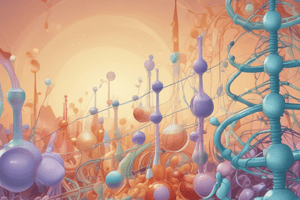Podcast
Questions and Answers
What is the primary structure of a protein?
What is the primary structure of a protein?
- The 3D folded structure of the protein
- The sequence of amino acids (correct)
- The presence of disulfide bonds
- The arrangement of multiple polypeptides
What is the consequence of a defect in the primary structure of a protein?
What is the consequence of a defect in the primary structure of a protein?
- It changes the protein's 3D structure
- It alters the arrangement of polypeptides
- It affects the formation of disulfide bonds
- It can lead to diseases (correct)
What is the significance of the N-terminal and C-terminal in a polypeptide chain?
What is the significance of the N-terminal and C-terminal in a polypeptide chain?
- They determine the direction of the sequence (correct)
- They control the protein's enzymatic activity
- They are responsible for protein denaturation
- They form hydrogen bonds with other chains
What type of amino acid residues are rarely found in the alpha helix due to their structural properties?
What type of amino acid residues are rarely found in the alpha helix due to their structural properties?
Which type of protein structure involves the 3-D arrangement of all atoms in a protein and contains the active site where reactions occur?
Which type of protein structure involves the 3-D arrangement of all atoms in a protein and contains the active site where reactions occur?
What gives strength and hardness to α-keratin in structures like rhinoceros horn?
What gives strength and hardness to α-keratin in structures like rhinoceros horn?
Which chemical sequencing process labels and removes the amino-terminal residue from a peptide, leaving all other peptides intact?
Which chemical sequencing process labels and removes the amino-terminal residue from a peptide, leaving all other peptides intact?
What technique is used to determine protein sequences and elucidate the history of life on earth?
What technique is used to determine protein sequences and elucidate the history of life on earth?
How is protein concentration commonly determined using UV spectrophotometry?
How is protein concentration commonly determined using UV spectrophotometry?
What is the primary structure of collagen?
What is the primary structure of collagen?
What causes denaturation of proteins?
What causes denaturation of proteins?
What is the structure of myoglobin?
What is the structure of myoglobin?
What is the predominant conformation of silk fibroin?
What is the predominant conformation of silk fibroin?
What is the function of vitamin C in relation to collagen?
What is the function of vitamin C in relation to collagen?
What is the structure of hemoglobin?
What is the structure of hemoglobin?
Collagen is a globular protein with a recognizable folding pattern involving two or more elements of secondary structure.
Collagen is a globular protein with a recognizable folding pattern involving two or more elements of secondary structure.
Silk fibroin is predominantly in the β conformation, rich in Ala and Gly residues.
Silk fibroin is predominantly in the β conformation, rich in Ala and Gly residues.
Denaturation of proteins is caused by disruption of the hydrophobic aggregation of nonpolar amino acid side chains and hydrogen bonds.
Denaturation of proteins is caused by disruption of the hydrophobic aggregation of nonpolar amino acid side chains and hydrogen bonds.
Myoglobin has a predominant antiparallel β conformation.
Myoglobin has a predominant antiparallel β conformation.
Collagen fibrils are made up of collagen in a parallel fashion and cross-linked for strength.
Collagen fibrils are made up of collagen in a parallel fashion and cross-linked for strength.
Explain the structure and composition of collagen fibrils at a molecular level, including the role of specific amino acid residues.
Explain the structure and composition of collagen fibrils at a molecular level, including the role of specific amino acid residues.
Discuss the significance of ascorbic acid (vitamin C) in maintaining the stability of collagen and the implications of vitamin C deficiency.
Discuss the significance of ascorbic acid (vitamin C) in maintaining the stability of collagen and the implications of vitamin C deficiency.
Provide an overview of the tertiary and quaternary structure of myoglobin, emphasizing its unique features and functional significance.
Provide an overview of the tertiary and quaternary structure of myoglobin, emphasizing its unique features and functional significance.
Study Notes
Protein Structure and Analysis Techniques
- Fredrick Sanger determined the amino acid sequence in bovine insulin in 1953.
- Edman's degradation is a two-step chemical sequencing process that labels and removes the amino-terminal residue from a peptide, leaving all other peptides intact.
- For larger proteins, disulfide bonds must be eliminated by performic acid or dithiothreitol (DTT).
- Mass spectrometry provides an alternative method to determine amino acid sequences, offering accurate molecular weight and short sequence determination in a short time.
- Two techniques developed to solve the problem of mass spectrometry not working for large macromolecules are MALDI MS and ESI MS.
- Tandem MS or MS/MS is used to determine protein sequences and elucidate the history of life on earth.
- Tracing evolution involves identifying suitable families of homologous proteins and using them to reconstruct evolutionary paths.
- Aromatic R groups in amino acids have various properties, including UV light absorption at 280 nm for protein characterization.
- Protein concentration can be determined using UV spectrophotometry and the Beer-Lambert equation.
- The Bradford assay uses a standard calibration curve of bovine serum albumin (BSA) to determine protein concentration.
- M1V1 = M2V2 equation is used to prepare stock solutions of protein standards.
- The common protein secondary structures include α-helix, β conformations, β-turn, and random coil, with the α-helix being observed in hair and porcupine quills.
Studying That Suits You
Use AI to generate personalized quizzes and flashcards to suit your learning preferences.
Related Documents
Description
Test your knowledge of protein structure and analysis techniques with this quiz. Explore topics such as amino acid sequencing, mass spectrometry, evolution tracing, protein characterization, and concentration determination.



